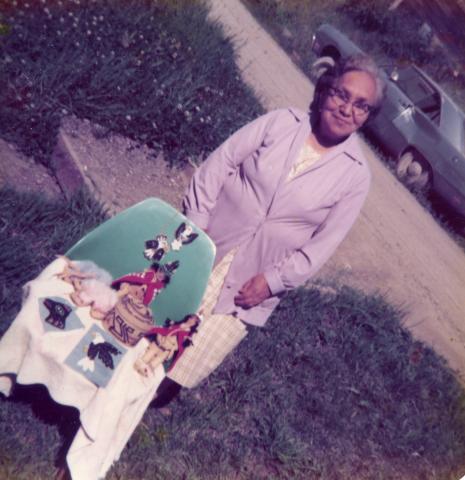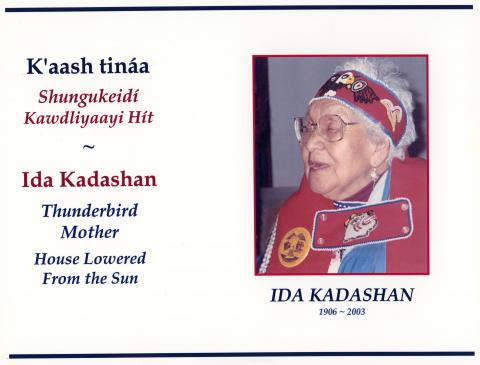Ida Kadashan Showing Some Of Her Dolls And Art
Ida Kadashan
Ida Kadashan was born in Hoonah on May 22, 1906, to Pete and Mary Hopkins, the youngest of six children. Her Tlingit name was Kaashtinaa and her nickname was Soonjeekoosa, she was Shungukeidí, Kaawdiyaayi Hít (Lowered From The Sky House) . Ida was the eldest Eagle-Thunderbird of a five-generation family. Her first husband was Lum See from Canton, China. Her second husband and father of her children, Luke Osborne, disappeared in a boating accident in 1940. His "clan brother" David P. Kadashan married her and helped raise her children. She worked at Excursion Inlet, the crab cannery in Hoonah, and the fish cannery in Hoonah the year it opened in 1912. She also ran the movie theater in Hoonah for several years.
She was involved in raising money for the Alaska Native Brotherhood, Alaska Native Sisterhood, ANSCA efforts, and the Hoonah ANB Hall. She was a lifetime member of ANS in Hoonah and served as secretary, treasurer and grand emeritus. Ida and David Kadashan held the ANS/ANB and junior meetings at their home before the hall was built in Hoonah.
She was a deacon and elder at the Presbyterian Church in Hoonah where she was also a lifetime member. She was a Huna Totem and Sealaska shareholder. She taught in Hoonah, Sitka, and Juneau, and won numerous ribbons for her exhibits at the state fair in Haines.
Her family said she loved her Tlingit way of life, preparing food, doing beadwork and spruce root basket weaving. They said that in all the important ways of her life, she never hesitated to be involved in her cultural ways, and she devoted her life to her family.
Kadashan was considered a master spruce root basket weaver. She won awards for her basket weaving from the state fair in Haines and was recognized for her work by basket weaving experts. During her life she was deeply interested in Alaska Native cultural activities. She taught Native culture at the Hoonah School and volunteered at the Alaska State Museum in Juneau. Later in life she did weaving at the Mount Roberts Tram and the Nakahidi Theater in Juneau.
In the book A Study of Traditional Use of Birds Eggs by The Huna Tlingit, Authors Eugene S. Hunn, Darryll R. Johnson, Priscilla N. Russell and Thomas F Thornton, Ida Kadashan related how it felt to gather her first gull eggs while still a child: “I sure want to find those seagull eggs. Sometimes I find one. I feel like I’m ... great....”
Ida Kadashan died March 3, 2002, in Juneau.
The above was gathered from the following sources: “Ida Hopkins Kadashan,” Obituary. Juneau Empire. March 5, 2003; Busby, Sharon. Spruce Root Basketry: Haida and Tlingit. Seattle: University of Washington Press, 2003; Gunther, Erna. Design Units on Tlingit Baskets. Juneau, AK: Alaska State Museum, 1984; Paul, Frances Lackey. Spruce Root Basketry of the Alaska Tlingit. Lawrence, KS: Bureau of Indian Affairs, 1944; www.sheldonmuseum.org





